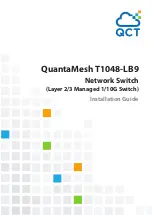
6.VLAN with Private VLAN
Since the iSpirit 3026 switch supports private VLAN, the “VLAN” is also called as normal VLAN.
Normal VLAN and private VLAN are mutually exclusive in some degree.
A normal VLAN represents a broadcast domain, each VLAN can form a sub-network, and
communication across VLANs should go through Layer 3 transmission; while for private VLAN,
a broadcast domain needs a private VLAN group. Each private VLAN group can form a
sub-network, which is created in the main VLAN of the private VLAN group. Communication
across multiple private VLAN groups should go through Layer 3 transmission, while
communication inside a group just needs Layer 2 transmission.
When creating a normal VLAN, users should make sure that the normal VLAN doesn’t fall in the
range of any private VLAN of any private VLAN group. Otherwise, it won’t be created.
When adding a port to a private VLAN, it can be a promiscuous port, a shared port or a
separated port. No matter what kind of port it is, if it’s an untagged member of a normal VLAN, it
should be removed from the normal VLAN first.
When adding a port to a normal VLAN, if the port already belongs to a private VLAN, it can’t be
set as an untagged member of the normal VLAN, but can be a tagged member.
The command “show vlan” will only show information for normal VLANs. To show private VLAN,
please use the command “show privatevlan”.
(Please refer to Chapter 4 for more information.)
7.Sub-networks of VLAN
A VLAN represents a broadcast domain in the iSpirit 3026 switch, and a subnet interface can be
created for each VLAN (actually all subnets are created based on VLAN.). The iSpirit 3026
switch can support a maximum number of 4094 VLANs, but can only have 26 subnets. After
creating subnets on 26 VLANs, other VLANs can’t have any more subnet.
3.2 VLAN configuration
For the convenience of users, the iSpirit 3026 switch provides various of commands for VLAN
















































